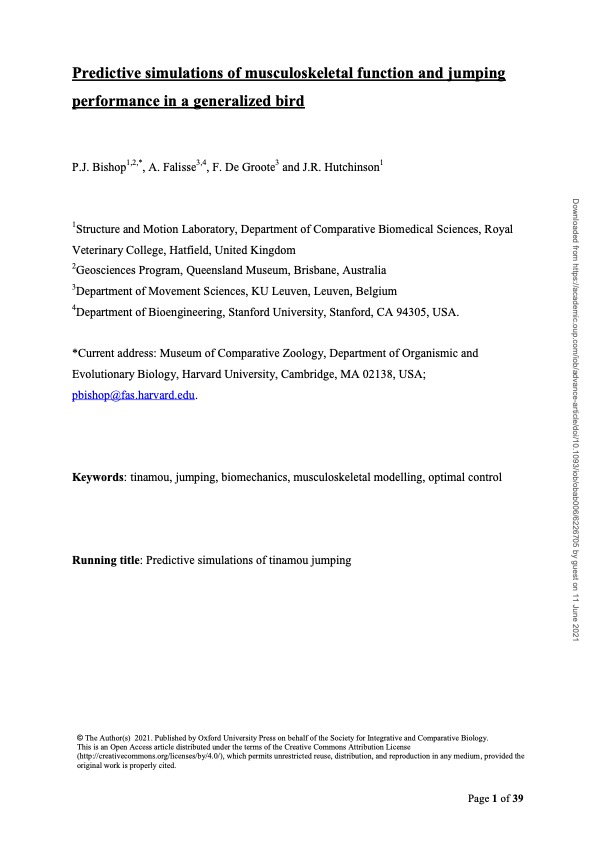P.J. Bishop
Predictive Simulations of Musculoskeletal Function and Jumping Performance in a Generalized Bird
Bishop, P.J.; Falisse, A.; De Groote, F.; Hutchinson, J.R.
Authors
A. Falisse
F. De Groote
J.R. Hutchinson
Abstract
Jumping is a common, but demanding, behavior that many animals employ during everyday activity. In contrast to jump-specialists such as anurans and some primates, jumping biomechanics and the factors that influence performance remains little studied for generalized species that lack marked adaptations for jumping. Computational biomechanical modeling approaches offer a way of addressing this in a rigorous, mechanistic fashion. Here, optimal control theory and musculoskeletal modeling are integrated to generate predictive simulations of maximal height jumping in a small ground-dwelling bird, a tinamou. A three-dimensional musculoskeletal model with 36 actuators per leg is used, and direct collocation is employed to formulate a rapidly solvable optimal control problem involving both liftoff and landing phases. The resulting simulation raises the whole-body center of mass to over double its standing height, and key aspects of the simulated behavior qualitatively replicate empirical observations for other jumping birds. However, quantitative performance is lower, with reduced ground forces, jump heights, and muscle-tendon power. A pronounced countermovement maneuver is used during launch. The use of a countermovement is demonstrated to be critical to the achievement of greater jump heights, and this phenomenon may only need to exploit physical principles alone to be successful; amplification of muscle performance may not necessarily be a proximate reason for the use of this maneuver. Increasing muscle strength or contractile velocity above nominal values greatly improves jump performance, and interestingly has the greatest effect on more distal limb extensor muscles (i.e., those of the ankle), suggesting that the distal limb may be a critical link for jumping behavior. These results warrant a reevaluation of previous inferences of jumping ability in some extinct species with foreshortened distal limb segments, such as dromaeosaurid dinosaurs.
Citation
Bishop, P., Falisse, A., De Groote, F., & Hutchinson, J. (in press). Predictive Simulations of Musculoskeletal Function and Jumping Performance in a Generalized Bird. Integrative Organismal Biology, https://doi.org/10.1093/iob/obab006
| Journal Article Type | Article |
|---|---|
| Acceptance Date | Apr 15, 2021 |
| Online Publication Date | Apr 15, 2021 |
| Deposit Date | Dec 10, 2020 |
| Publicly Available Date | Jun 11, 2021 |
| Journal | Integrative Organismal Biology |
| Print ISSN | 2517-4843 |
| Electronic ISSN | 2517-4843 |
| Publisher | Oxford University Press |
| Peer Reviewed | Peer Reviewed |
| DOI | https://doi.org/10.1093/iob/obab006 |
| Public URL | https://rvc-repository.worktribe.com/output/1442021 |
Files
OA AAM
(77 Kb)
Image
Publisher Licence URL
http://creativecommons.org/licenses/by/4.0/
You might also like
The evolution of femoral morphology in giant non-avian theropod dinosaurs
(2024)
Journal Article
Estimation of the forces exerted on the limb long bones of a White Rhinoceros
(2024)
Journal Article
Downloadable Citations
About RVC Repository
Administrator e-mail: publicationsrepos@rvc.ac.uk
This application uses the following open-source libraries:
SheetJS Community Edition
Apache License Version 2.0 (http://www.apache.org/licenses/)
PDF.js
Apache License Version 2.0 (http://www.apache.org/licenses/)
Font Awesome
SIL OFL 1.1 (http://scripts.sil.org/OFL)
MIT License (http://opensource.org/licenses/mit-license.html)
CC BY 3.0 ( http://creativecommons.org/licenses/by/3.0/)
Powered by Worktribe © 2025
Advanced Search

